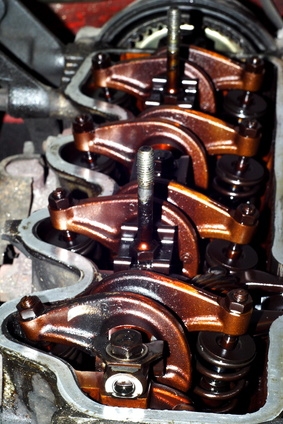
Changing a timing belt can be relatively easy, or be an arduous undertaking. The complexity of the job depends on several factors, such as the make of the car, the position of the engine (in line or transverse) and the engine design (single cam, double or quad cam). The most important consideration before you remove the belt is the proper alignment of the cam and crank shafts at their top dead center (TDC) timing marks and maintaining those exact positions throughout the replacement process.
Draw a diagram of how the fan belt fits around the various pulleys. Then, loosen the alternator tension bolt and remove the belt. Disconnect and remove any engine parts still obstructing your access to the top timing belt cover located on the front of the engine block below the fan belt pulley. Undo the bolts and remove the cover. The lower timing belt cover is reached from under the front bumper, assuming the engine is forward-facing. Unbolt the lower cover and remove the harmonic balancer attached to the end of the crank shaft pulley by removing the center bolt and pulling the balancer off the shaft with the pulley extractor.
Have someone turn the ignition key to start for a fraction of a second while you observe the crank pulley's direction of travel. It will probably be clockwise. With a transversely mounted engine, you will have to support the bottom of the block with a floor jack before removing the passenger's-side motor mount to access the timing belt cover. Also, with this engine configuration, you must jack up the car and remove the tire and wheel well mud skirt to reach the lower timing belt cover.
Highlight the timing mark on the side of the cam shaft pulley with a dab of white paint and another dab on the timing mark that's on the casing. Make the same reference marks on the lower crank pulley and engine block timing marks. Make sure the cam and crank shafts are all dead on their timing marks before removing the old belt. Failure to maintain the exact positions of the cam and crank shafts during belt replacement may cause the pistons to smack into and bend the valves in an "interference" engine.
Loosen the center bolt on the small tensioner pulley to remove the timing belt. You can identify the pulley by either the spring attached to it or the small off-center bolt next to a larger center bolt. With the tension removed, the old belt will come right off, but first, draw a diagram of the way the serpentine belt fits around all the pulleys. Before mounting the new belt, examine the area around the water pump pulley for coolant leaks. Then, carefully install the new belt without disturbing the cam and crank pulleys and tighten the tensioner pulley against the belt.
Turn the crank shaft two full turns in the proper direction to see if the cam pulley timing marks again exactly line up. Reassemble the car.